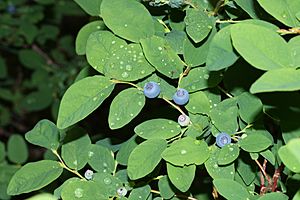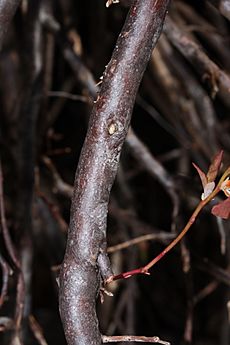Vaccinium ovalifolium facts for kids
Quick facts for kids Vaccinium ovalifolium |
|
|---|---|
 |
|
| Mount Baker-Snoqualmie National Forest, Washington | |
| Conservation status | |
| Scientific classification | |
| Kingdom: | |
| (unranked): | |
| (unranked): | |
| (unranked): | |
| Order: | |
| Family: | |
| Genus: | |
| Species: |
V. ovalifolium
|
| Binomial name | |
| Vaccinium ovalifolium Sm. 1817
|
|
| Varieties | |
|
|
| Synonyms | |
Vaccinium ovalifolium (commonly known as Alaska blueberry, early blueberry, oval-leaf bilberry, oval-leaf blueberry, and oval-leaf huckleberry) is a plant in the heath family having three varieties, all of which grow in northerly regions, including the subarctic.
Growth
Vaccinium ovalifolium is a spreading shrub which may grow to 5 feet (1.5 m) tall. It has pink 1⁄4 in (0.64 cm) urn-shaped flowers. Berries are dark blue, often black, sometimes with a waxy coating.
Distribution
The original variety (i.e. the automatically named Vaccinium ovalifolium var[iety] ovalifolium) is found on both the eastern and western sides of the Pacific Ocean; in North America, it is distributed in Canada (in Alberta, British Columbia, Newfoundland, Nova Scotia, southern Ontario, south central Quebec, and southern Yukon Territory); and the United States (in southern Alaska, Idaho, northern Michigan, Oregon, western South Dakota, and Washington); across the Pacific to Asia and Eurasia, it is distributed in Russia (in Kamchatka, the southern Kuril Islands, Primorsky Krai, and Sakhalin); and in Japan (in Hokkaido, and central and northern Honshu).
- The two other varieties are confined to Japan and Russia:
- V. o. var. sachalinense is only found in Sakhalin in Russia, and Hokkaido in Japan.
- V. o. var. alpinum is distributed only within the Daisetsu and Hidaka Mountains, both on the island of Hokkaido.
Uses
Vaccinium ovalifolium is used in jams and jellies and for making liqueur. Blueberry herbal tea can be made from the leaves, or from the juice of the blueberries themselves.
Vaccinium ovalifolium has been used in Russia in the making of dyes, including the use of its tannin.
In the winter, Vaccinium ovalifolium is an important food source for grazing deer, goats, and elk, and in the summer the nectar feeds hummingbirds.



